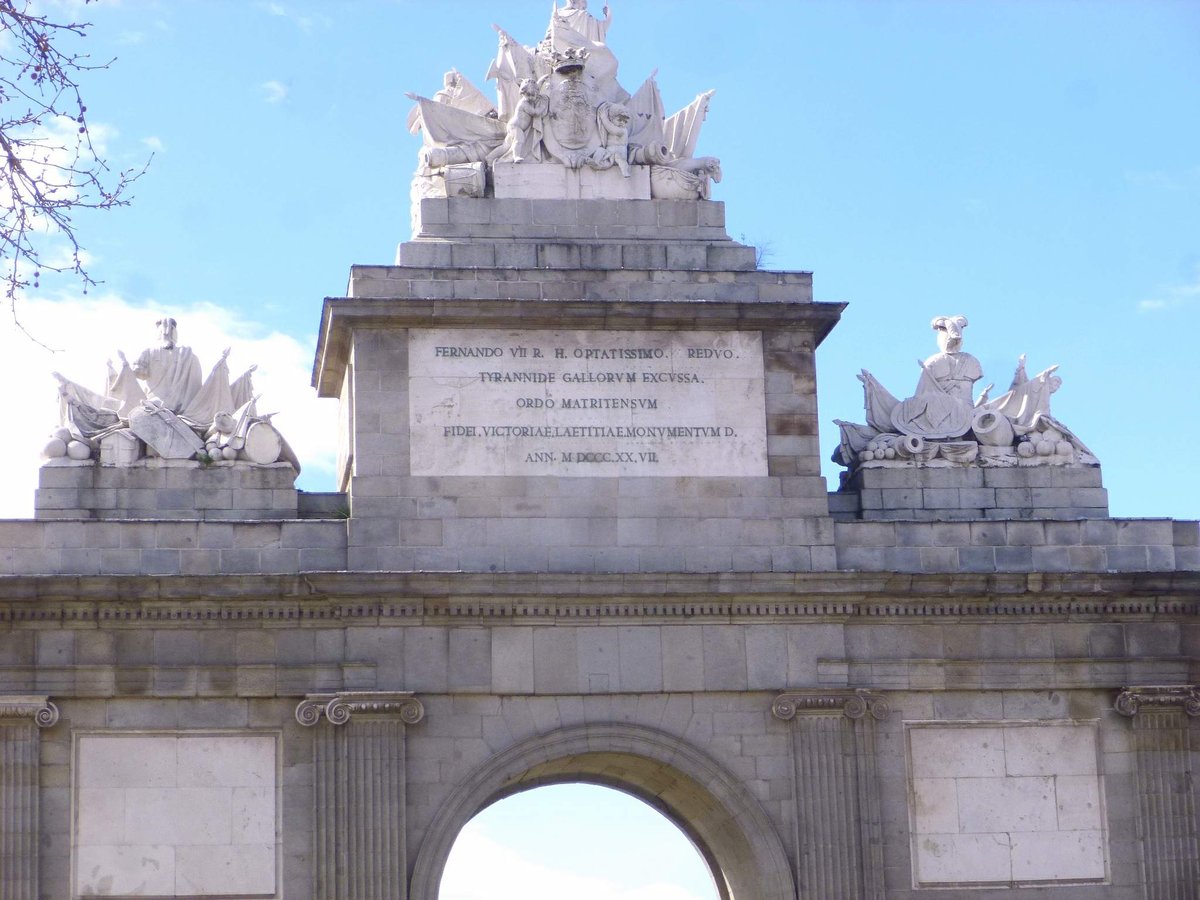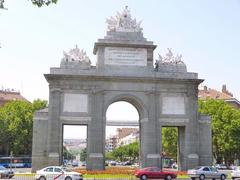
Gate of Toledo Visiting Hours, Tickets, and Madrid Historical Sites Guide
Date: 14/06/2025
Introduction
The Gate of Toledo (Puerta de Toledo) stands as one of Madrid’s most distinguished neoclassical monuments, offering visitors a vivid window into the city’s layered history, architectural splendor, and vibrant urban culture. Completed in 1827 after a turbulent period marked by Napoleonic occupation and the restoration of the Spanish monarchy, the gate has transitioned from a functional city entrance to a cherished open-air landmark. Located in the lively La Latina district, it is surrounded by bustling markets, authentic tapas bars, and the rejuvenated Madrid Río park. This guide provides everything you need to know about visiting the Gate of Toledo, including historical background, architectural highlights, practical visitor tips, accessibility, nearby attractions, and FAQs, ensuring a rewarding and memorable experience (madrid.city-tour.com, Spain.info, es.wikipedia.org).
Table of Contents
- Introduction
- Origins and Historical Context
- Urban Development and the Role of City Gates
- Architectural Features and Symbolism
- Visiting the Gate of Toledo: Hours, Tickets, and Accessibility
- Special Events and Guided Tours
- Integration with Modern Madrid
- Visuals and Media
- Related Articles
- Frequently Asked Questions (FAQ)
- Conclusion
- Call to Action
- References
Origins and Historical Context
The Gate of Toledo is deeply intertwined with Madrid’s history. Its construction began in 1812 during the Napoleonic occupation of Spain, initially commissioned by Joseph Bonaparte, Napoleon’s brother. The purpose was to create a majestic southern entrance that reflected both modernization and imperial power (madrid.city-tour.com). After French troops withdrew, the gate’s role shifted to a symbol of Spanish triumph and the restoration of King Ferdinand VII. Completed in 1827, it was the last monumental gate built in Madrid, commemorating the end of the Peninsular War and the monarchy’s restoration (mypathintheworld.com).
Urban Development and the Role of City Gates
Madrid’s cityscape has long been shaped by its defensive walls and gates. The earliest version of the Puerta de Toledo dates back to the 15th century, serving as a critical checkpoint on the road to Toledo (es.wikipedia.org). As the city grew, walls and gates were rebuilt and relocated, reflecting shifting needs for defense and urban expansion. By the 19th century, gates like Puerta de Toledo marked important city entrances, symbolizing prestige and security, while facilitating the movement of people and goods (mypathintheworld.com).
Architectural Features and Symbolism
Standing 19 meters tall and constructed mainly from robust granite, the Gate of Toledo is a prime example of neoclassical architecture. The monument is composed of a central semicircular arch, flanked by two rectangular lintelled side gates originally intended for pedestrians. Engaged Doric columns, classical pilasters, and sculptural reliefs decorate the structure, while the upper frieze celebrates the return of King Ferdinand VII and Spain’s victory over French occupation. Allegorical stone figures atop the gate represent Madrid and the Spanish monarchy, reinforcing themes of resilience and unity (Spain.info, esmadrid.com).
Visiting the Gate of Toledo: Hours, Tickets, and Accessibility
- Visiting Hours: The Gate of Toledo is an open-air monument, accessible 24/7. There are no restrictions on visiting times.
- Tickets: Admission is free; there are no tickets required.
- Accessibility: The area is wheelchair accessible with smooth sidewalks and public transport access. Some surrounding streets have cobblestones, which may be uneven in places.
- Getting There:
- Metro: Puerta de Toledo (Line 5) station is steps from the monument.
- Bus: Multiple bus lines (23, 35, 50) stop nearby.
- On Foot: A pleasant 15–20 minute walk from Plaza Mayor along Calle de Toledo.
- Taxi/Rideshare: Use the address “Gta. de la Prta de Toledo, 28005 Madrid” (Evendo).
Special Events and Guided Tours
The Gate of Toledo is often featured in guided walking tours of Madrid’s historic neighborhoods, especially La Latina. During local festivals and on Sundays, the surrounding area comes alive with the famous El Rastro flea market and community events, offering an authentic Madrid experience. Check with local tour operators or the official Madrid tourism website for current tour offerings and cultural activities (es.wikipedia.org).
Integration with Modern Madrid
Though the gate no longer serves as a functional city entrance, it remains a prominent landmark within a bustling roundabout. Restoration efforts in 1995 preserved its neoclassical features, while the Madrid Río revitalization project has enhanced the nearby riverbanks with green spaces, pedestrian bridges, and recreational areas. The adjacent La Latina and Embajadores districts are lively hubs for dining, shopping, and nightlife, making the Gate of Toledo both a historical monument and a contemporary meeting point (west8.com, archdaily.com).
Visuals and Media
- Photography Tips: Best captured during early morning or late afternoon for optimal lighting. Nighttime illumination highlights its sculptural details.
- Virtual Resources: High-quality images and virtual tours are available online, often with descriptive alt tags such as “Gate of Toledo Madrid neoclassical monument” and “Night illumination of Gate of Toledo Madrid.”
- Maps: Embed or consult interactive maps to locate nearby attractions and transport options (Evendo).
Nearby Attractions and Local Experiences
- El Rastro Market: Madrid’s largest open-air flea market, held every Sunday and public holiday, is just a short walk away.
- La Latina District: Renowned for its tapas bars, historic ambiance, and vibrant nightlife (timeout.com).
- Plaza Mayor: A 15–20 minute walk away, ideal for combining with your visit.
- Royal Palace and Almudena Cathedral: Both within walking distance, perfect for a broader sightseeing itinerary.
- Mercado Puerta de Toledo: Offers fresh produce and local delicacies.
Practical Visitor Tips
- Traffic Awareness: The monument is in a busy roundabout; use pedestrian crossings.
- Weather: Summers can be hot—bring water, sunscreen, and a hat.
- Restrooms: Available in nearby cafes and restaurants.
- Language: Basic Spanish phrases are helpful, though many locals speak some English.
- Etiquette: Respect the monument by not climbing or littering.
Frequently Asked Questions (FAQ)
Q: What are the Gate of Toledo visiting hours?
A: The monument is outdoors and accessible 24/7.
Q: Is there an entry fee?
A: No, the site is free to visit.
Q: Is the gate wheelchair accessible?
A: Yes, though some surrounding streets may have uneven cobblestones.
Q: How do I get there by public transport?
A: Take Metro Line 5 to Puerta de Toledo station or use bus lines 23, 35, or 50.
Q: Are guided tours available?
A: Yes, the gate is included in many guided walking tours of Madrid.
Q: Can I enter the gate?
A: The interior is not open to the public; visitors can explore the exterior and surrounding gardens.
Conclusion
The Gate of Toledo remains a vital emblem of Madrid’s historical resilience, neoclassical artistry, and urban vitality. As the city’s last monumental gate, it offers a tangible link to Madrid’s storied past and serves as a vibrant focal point in the contemporary urban landscape. Free and accessible at all hours, the gate is a must-see for history enthusiasts, architecture admirers, and travelers seeking authentic cultural experiences. Combine your visit with the neighboring attractions and lively markets to fully immerse yourself in the heart of Madrid.
Call to Action
Plan your exploration today! Download the Audiala app for expert-led guided tours, interactive maps, and real-time updates on Madrid’s historical sites. Follow us on social media for the latest news, and browse our related articles to enrich your journey through Spain’s capital.
Key Facts at a Glance
- Height: 19 meters (Spain.info)
- Material: Granite with stone sculptural elements
- Architectural Style: Neoclassical with Doric columns and pilasters
- Location: Glorieta de la Puerta de Toledo, Madrid
- Access: Free, open to the public 24/7
Useful Resources and Internal Links
References
- Gate of Toledo Madrid: Visiting Hours, Tickets, and Historical Guide, 2025, Madrid City Tour (madrid.city-tour.com)
- Architectural Features and Visitor Guide to the Gate of Toledo, Madrid, 2025, Spain.info (Spain.info)
- Puerta de Toledo Visiting Hours, Tickets, and Guide to Madrid’s Historic Gate, 2025, Wikipedia (es.wikipedia.org)
- Gate of Toledo Visiting Hours, Tickets, and Guide to Madrid’s Historic Landmark, 2025, Evendo (Evendo)


































































































